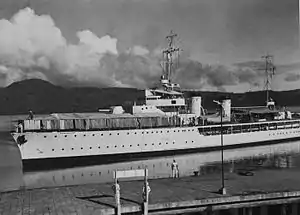French aviso Dumont d'Urville
Dumont d'Urville was a Bougainville-class aviso of the French Navy, designed to operate from French colonies in Asia and Africa. She was built by Ateliers et Chantiers Maritime Sud-Ouest of Bordeaux and launched on 21 March 1931.[1]
 Dumont d'Urville arrives at the wharf. | |
| History | |
|---|---|
| Name | Dumont d'Urville |
| Namesake | Dumont d'Urville |
| Builder | At. et Ch. Maritime Sud-Ouest, Bordeaux |
| Launched | 21 March 1931[1] |
| Fate | Scrapped 26 March 1958[1] |
| General characteristics | |
| Type | Bougainville-class aviso |
| Displacement | |
| Length | 103.7 m (340 ft 3 in) (o/a) |
| Beam | 12.7 m (41 ft 8 in) |
| Draught | 4.15 m (13 ft 7 in) |
| Installed power | 2,100 PS (1,500 kW; 2,100 bhp) |
| Propulsion | 2 shafts; 2 diesel engines |
| Speed | 15.5 knots (28.7 km/h; 17.8 mph) |
| Range | 9,000 nmi (17,000 km; 10,000 mi) at 14 knots (26 km/h; 16 mph) |
| Complement |
|
| Armament |
|
| Armour |
|
| Aircraft carried | 1 × Gourdou-Leseurre GL-832 HY floatplane |
Service history

After the Fall of France Dumont d'Urville remained under Vichy French control and in September 1940 she was in New Caledonia as a part the Vichy government's attempt to gain control of the French colony. However, the Royal Australian Navy cruiser Adelaide arrived carrying a Free French temporary governor, which led the Vichy governor to depart aboard Dumont d'Urville on 25 September.[2]
On the night of 16–17 January 1941 Dumont d'Urville took part in the Battle of Koh Chang.[3]
In September 1942 Dumont d'Urville took part in rescuing survivors from RMS Laconia which the German submarine U-156 had torpedoed and sunk, known as the Laconia incident.
By 1944 Dumont d'Urville's armament had been augmented with the addition of four single-mounted 40 mm anti-aircraft (AA) guns, 11 single-mounted 20 mm AA guns, four anti-submarine mortars and two racks for 66 depth charges.[1]
Dumont d'Urville remained in French Navy service after the war until 26 March 1958 when she was scrapped.[1]
References
- Le Masson 1969, p. 12.
- Cassells 2000, p. 7.
- "La bataille de Koh Chang (janvier 1941)". Croiseur Lamotte-Picquet. Net-Marine.
Sources
- Chesneau, Roger, ed. (1980). Conway's All the World's Fighting Ships 1922–1946. Greenwich, UK: Conway Maritime Press. ISBN 0-85177-146-7.
- Cassells, Vic (2000). The Capital Ships: Their Battles and Their Badges. East Roseville, NSW: Simon & Schuster. ISBN 0-7318-0941-6. OCLC 48761594.
- Jordan, John (2016). "The Colonial Sloops of the Bougainville Class". Warship 2007. London: Conway. pp. 8–29. ISBN 978-1-84486-326-6.
- Le Masson, Henri (1969). The French Navy. Navies of the Second World War. Vol. 2. London: MacDonald & Co. ISBN 0-356-02385-0.
- Rohwer, Jürgen (2005). Chronology of the War at Sea 1939–1945: The Naval History of World War Two (Third Revised ed.). Annapolis, Maryland: Naval Institute Press. ISBN 1-59114-119-2.